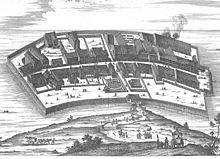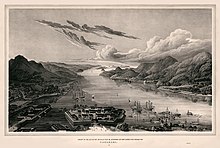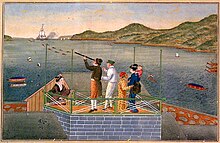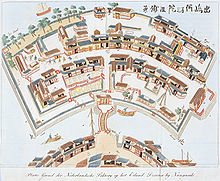Dejima




Dejima ( Japanese 出 島 , German roughly: "sub-island", in the 17th century also Tsukishima 築 島 , "heaped up island") was a fan-shaped small artificial island in the bay of Nagasaki . During the Edo period it was the only place of direct trade and exchange between Japan and Europe . In modern Japanese the pronunciation of the name in the syllabary scripts Hiragana and Katakana is reproduced as で じ ま or デ ジ マ and accordingly transcribed in Hepburn transcription as Dejima. In the Edo period, spellings like "Disma", "Decima", "Dezima", "Desima", "Desjima" and "Deshima" can be found in western reports. There is also evidence in Japanese sources that the pronunciation at that time was closer to the spelling Deshima ( で し ま ).
history
Heaped up by local merchants between 1634 and 1636, Dejima was supposed to accommodate the "southern barbarians" ( Nambanjin ) who lived scattered around the city . But after their expulsion, the island lay fallow. Since the local economy also fell into crisis with the absence of Portuguese merchant ships, the central government in Edo put pressure on the Dutch East India Company ( Verenigde Oostindische Compagnie or VOC ) until it relocated its trading post in Hirado here in 1640/41.
The land was privately owned by the merchants who had raised the capital for the land reclamation. The company paid an annual rent for its use and had to take care of maintaining the building. Since 1672 Dejima was a district of Nagasaki, which is why there was also a Japanese district chief (Japanese otona ) here. The governor of the imperial direct domain Nagasaki was responsible for the security and surveillance of the island. The Japanese service personnel were paid by the company, but were obliged by an oath to comply with various regulations of the governor. Japanese interpreters took care of the communication; the training of European language mediators remained banned until the 19th century.
Lower ranks of the VOC were sometimes allowed to live on Dejima for several years, but the leaders (ndl. Opperhoofden ) had to be changed after a year. They arrived on one of the East India Company ships in the summer and began their service when their predecessor left, usually in November. These leaders, known by the Japanese as kapitan (portug. Capitão ), were obliged to travel to Edo once a year (after 1790 only every four years) in order to express the company's gratitude for the approval of their trade in Japan by paying tribute in the castle bring to. The doctor from the trading station, who was highly valued by both high-ranking patients and Japanese colleagues, was allowed to take part in this court trip to Edo . As (temporary) residents of a district, the Europeans, under the supervision of numerous Japanese officials, were also allowed to attend the annual festivities in honor of Nagasaki's patron deity in the Suwa Shrine ( Suwa jinja ).
Otherwise, the employees of the VOC were limited to the island of Dejima. Access was regulated and controlled. The close coexistence and mutual dependency made it possible, however, that in addition to official trade, lively private trade and smuggling spread. This was usually tolerated. Personal requests from high-ranking figures in Edo were granted as quickly as possible, as such favors improved the environment for official trading. Through Dejima, numerous western books, instruments, medicines and information came into the country through Dejima up to the 19th century, which stimulated the rise of a so-called Dutch lore ( rangaku ) and formed the basis for the rapid modernization of Japan after 1868 . On the other hand, Japanese objects, books, maps, etc. were repeatedly carried on Dutch ships, which raised the level of knowledge of Europeans. During the coalition wars, the Dutch flag only waved in Nagasaki worldwide.
Some of the surgeons and doctors stationed on Dejima, such as Caspar Schamberger , Engelbert Kaempfer , Carl Peter Thunberg or Philipp Franz von Siebold , had a great influence on the development of Japanese medicine. Engelbert Kaempfer, Carl Peter Thunberg, Philipp Franz von Siebold, George Meister , but also factories such as Andreas Cleyer , Isaac Titsingh , Hendrik Doeff or Jan Cock Blomhoff carried out intensive regional studies during their stay and contributed to the European understanding of Japan through their publications and collections so-called age of the national degree ( sakoku ). Much of the early information about acupuncture and moxibustion was conveyed to Europe by Willem ten Rhijne and other doctors from this trading post.
After the opening of Japan in the second half of the 19th century, Dejima moved into the city center of Nagasaki in the course of the reclamation and was hardly recognizable in the 20th century. Most of the buildings have now been reconstructed on the basis of old plans and models, and almost the entire property has been brought together again, so that the visitor can get a good impression of the trade and change of Europeans in Japan at the beginning of the 19th century.
Head ( opperhoofden ) of the Dejima trading post
- François Caron : February 3, 1639-13. February 1641
- Maximiliaen Le Maire : February 14, 1641-30. October 1641
- Jan van Elseracq : November 1, 1641-29. October 1642
- Pieter Anthonijszoon Overtwater : October 29, 1642–1. August 1643
- Jan van Elserac : August 1, 1643-24. November 1644
- Pieter Anthonijszoon Overtwater : November 24, 1644-30. November 1645
- Reijnjer van't On : November 30, 1645-27. October 1646
- Willem Verstegen : October 28, 1646-10. October 1647
- Frederick Coijet : November 3, 1647-9. December 1648
- Dircq Snoecq : December 9, 1648-5. November 1649
- Anthonio van Brouckhorst : November 5, 1649-25. October 1650
- Pieter Sterthemius : October 25, 1650–3. November 1651
- Adriaen van der Burgh : November 1, 1651–3. November 1652
- Frederick Coijet : November 4, 1652-10. November 1653
- Gabriel Happart : November 4, 1653–31. October 1654
- Leonard Winninx : October 31, 1654-23. October 1655
- Joan Boucheljon : October 23, 1655–1. November 1656
- Zacharias Wagner [Wagenaer]: November 1, 1656-27. October 1657
- Joan Boucheljon : October 27, 1657-23. October 1658
- Zacharias Wagner [Wagenaer]: October 22, 1658–4. November 1659
- Joan Boucheljon: November 4, 1659 - October 26, 1660
- Hendrick Indijck : October 26, 1660-21. November 1661
- Dirck van Lier : November 11, 1661–6. November 1662
- Hendrick Indijck: November 6, 1662-20. October 1663
- Willem Volger : October 20, 1663–7. November 1664
- Jacob Gruijs : November 7, 1664-27. October 1665
- Willem Volger: October 28, 1665-27. October 1666
- Daniel Six [Sicx]: October 18, 1666–6. November 1667
- Constantin Ranst : November 6, 1667-25. October 1668
- Daniel Six [Sicx]: October 25, 1668-14. October 1669
- Francois de Haas : October 14, 1669–2. November 1670
- Martinus Caesar : November 2, 1670-12. November 1671
- Johannes Camphuys : October 22, 1671-12. November 1672
- Martinus Caesar: November 13, 1672-29. October 1673
- Johannes Camphuys: October 29, 1673-19. October 1674
- Martinus Caesar: October 20, 1674–7. November 1675
- Johannes Camphuys: November 7, 1675-27. October 1676
- Dirck de Haas : October 27, 1676-16. October 1677
- Albert Brevincq : October 16, 1677–4. November 1678
- Dirck de Haas: November 4, 1678-24. October 1679
- Albert Brevincq : October 24, 1679-11. November 1680
- Isaac van Schinne : November 11, 1680–31. October 1681
- Hendrick Canzius : October 31, 1681-20. October 1682
- Andreas Cleyer : October 20, 1682–8. November 1683
- Constantijn Ranst de Jonge : November 8, 1683-28. October 1684
- Hendrick van Buijtenhem : October 25, 1684–7. October 1685
- Andreas Cleyer: October 17, 1685-5. November 1686
- Constantin Ranst de Jonge: November 5, 1686-25. October 1687
- Hendrick van Buijtenhem: October 25, 1687-13. October 1688
- Cornelisz van Outhoorn : October 13, 1688–1. November 1689
- Balthasar Sweers : November 1, 1689-21. October 1690
- Hendrick van Buijtenhem: October 21, 1690–9. November 1691
- Cornelisz van Outhoorn: November 9, 1691-29. October 1692
- Hendrick van Buijtenhem: October 29, 1692-19. October 1693
- Gerrit de Heere : October 19, 1693–7. November 1694
- Hendrik Dijkman : November 7, 1694-27. October 1695
- Cornelisz van Outhoorn: October 27, 1695–15. October 1696
- Hendrik Dijkman: October 15, 1696–3. November 1697
- Pieter de Vos : November 3, 1697-23. October 1698
- Hendrik Dijkman: October 23, 1698–12. October 1699
- Pieter de Vos: October 21, 1699-31. October 1700
- Hendrik Dijkman: October 31, 1700–21. October 1701
- Abraham Douglas : October 21, 1701-30. October 1702
- Ferdinand de Groot : November 9, 1702-30. October 1703
- Gideon Tant : October 30, 1703-18. October 1704
- Ferdinand de Groot: October 18, 1704–6. November 1705
- Ferdinand de Groot: October 26, 1706-15. October 1707
- Hermanus Menssingh: October 15, 1707–2. November 1708
- Jasper van Mansdale : November 2, 1708-22. October 1709
- Hermanus Menssingh: October 22, 1709-10. November 1710
- Nicolaas Joan van Hoorn : November 10, 1710-31. October 1711
- Cornelis Lardijn : October 31, 1711–7. November 1713
- Cornelis Jardijn: November 7, 1713-27. October 1714
- Nicolaas Joan van Hoorn: October 27, 1714-19. October 1715
- Gideon Boudaen : October 19, 1715–3. November 1716
- Joan Aouwer : November 3, 1716-24. October 1717
- Christiaen van Vrijbergh [e]: October 24, 1717-13. October 1718
- Joan Aouwer: October 13, 1718-21. October 1720
- Roeloff Diodati : October 21, 1720-9. November 1721
- Hendrik Durven : November 9, 1721-18. October 1723
- Johannes Thedens : October 18, 1723-25. October 1725
- Joan de Hartogh : October 25, 1725-15. October 1726
- Pieter Boockestijn : October 15, 1726–3. November 1727
- Abraham Minnedonk : November 3, 1727-20. October 1728
- Pieter Boockestijn: October 22, 1728-12. October 1729
- Abraham Minnedonk: October 12, 1729–31. October 1730
- Pieter Boockestijn: October 31, 1730–7. November 1732
- Hendrik van de Bel : November 7, 1732-27. October 1733
- Rogier de Laver : October 27, 1733-16. October 1734
- David Drinckman : October 16, 1734-4. November 1735
- Bernardus Coop [Coopa] à Groen: November 4, 1735–24. October 1736
- Jan van der Cruijsse : October 24, 1736–13. October 1737
- Gerardus Bernardus Visscher : October 13, 1737-21. October 1739
- Thomas van Rhee : October 22, 1739–8. November 1740
- Jacob van der Waeijen : November 9, 1740-28. October 1741
- Thomas van Rhee: October 29, 1741-17. October 1742
- Jacob van der Waeijen: October 17, 1742–9. November 1743
- David Brouwer : November 5, 1743–1. November 1744
- Jacob van der Waeijen: November 2, 1744-28. December 1745
- Jan Louis de Win : December 30, 1745–2. November 1746
- Jacob Balde : November 3, 1746-25. October 1747
- Jan Louis de Win: October 28, 1747-11. November 1748
- Jacob Balde: November 12, 1748 - December 8, 1749
- Hendrik van Homoed : December 8, 1749-24. December 1750
- Abraham van Suchtelen : December 25, 1750-18. November 1751
- Hendrik van Homoed: November 19, 1751-5. December 1752
- David Boelen : December 6, 1752-15. October 1753
- Hendrik van Homoed: October 16, 1753–3. November 1754
- David Boelen: November 4, 1754-25. October 1755
- Herbert Vermeulen : October 25, 1755-12. October 1756
- David Boelen: October 13, 1756-31. October 1757
- Herbert Vermeulen: November 1, 1757-11. November 1758
- Johannes Reijnouts : November 12, 1758–11. November 1760
- Marten Huijshoorn : November 12, 1760–30. October 1761
- Johannes Reijnouts: October 31, 1761–2. December 1762
- Fredrik Willem Wineke : December 3, 1762–6. November 1763
- Jan Crans : November 7, 1763-24. October 1764
- Fredrik Willem Wineke: October 25, 1764–7. November 1765
- Jan Crans: November 8, 1765-31. October 1766
- Herman Christiaan Kastens : November 1, 1766-20. October 1767
- Jan Crans: October 21, 1767–8. November 1769
- Olphert Elias : November 9, 1769-16. November 1770
- Daniel Armenault : November 17, 1770-9. November 1771
- Arend Willem Feith : November 10, 1771–3. November 1772
- Daniel Armenault [Almenaault]: November 4, 1772-22. November 1773
- Arend Willem Feith: November 23, 1773-10. November 1774
- Daniel Armenault [Almenaault]: November 11, 1774-28. October 1775
- Arend Willem Feith: October 28, 1775-22. November 1776
- Hendrik Godfried Duurkoop : November 23, 1776–11. November 1777
- Arend Willem Feith: November 12, 1777-28. November 1779
- Isaac Titsingh : Nov. 29, 1779-5. November 1780
- Arend Willem Feith: November 6, 1780-23. November 1781
- Isaac Titsingh: Nov. 24, 1781-26. October 1783
- Hendrik Casper Romberg : October 27, 1783– _. August 1784
- Isaac Titsingh: _. August 1784-30. November 1784
- Hendrik Casper Romberg: November 0, 84-21. November 1785
- Johan Fredrik van Rheede dead de Parkeler : November 22, 1785-20. November 1786
- Hendrik Casper Romberg: November 21, 1786–30. November 1787
- Johan Frederik van Rheede dead de Parkeler: December 1, 1787–1. August 1789
- Hendrik Casper Romberg: August 1, 1789–13. November 1790
- Petrus Theodorus Chassé : November 13, 1790-13. November 1792
- Gijsbert Hemmij : November 13, 1792–8. July 1798
- Leopold Willem Ras : July 8, 1798–17. July 1800
- Willem Wardenaar : July 16, 1800-14. November 1803
- Hendrik Doeff : November 14, 1803–6. December 1817
- Jan Cock Blomhoff : December 6, 1817-20. November 1823
- Johan Willem de Sturler : November 20, 1823–5. August 1826
- Germain Felix Meijlan : August 4, 1826–1. November 1830
- Jan Willem Fredrik van Citters : November 1, 1830-30. November 1834
- Johannes Erdewin Niemann : December 1, 1834-17. November 1838
- Eduard Grandisson : November 18, 1838– _. November 1842
- Pieter Albert Bik : _. November 1842-31. October 1845
- Joseph Henrij Levijssohn : November 1, 1845–31. October 1850
- Frederick Colnelis Rose : November 1, 1850-31. October 1852
- Janus Henricus Donker Curtius : November 2, 1852-28. February 1860
further reading
- Jan Cock Blomhoff: The Court Journey to the Shogun of Japan. From a private account by Jan Cock Blomhoff. Introduction and annotated by Matthi Forrer. Hotei, Leiden 2000, ISBN 90-74822-18-5 .
- Leonard Blussé et al. (Ed.): The Deshima Dagregisters. Their Original Tables of Content. Leiden Center for the History of European Expansion, Leiden 1995-2001, ( Intercontinenta . ISSN 0165-2850 ).
- Leonard Blussé et al. (Ed.): The Deshima Diaries Marginalia 1740-1800. The Japan-Netherlands Institute, Tokyo 2004, ISBN 4-930921-06-6 ( Nichi-Ran Gakkai gakujutsu sōsho 21).
- CR Boxer : Jan Compagnie in Japan, 1600-1850. An Essay on the Cultural, Artistic and Scientific Influence Exercised by the Hollanders in Japan from the Seventeenth to the Nineteenth Centuries. Second revised edition. Martinus Nijhoff, The Hague 1950.
- F. Caron, Joost Schorten: A True Description of the Mighty Kingdoms of Japan and Siam. For Robert Boulter, London 1671 (Facsimile: Introduction and notes by John Villiers. Siam, Bangkok 1986, ISBN 974-8298-08-6 ).
- Hendrik van Doeff: Herinneringen uit Japan. Bohn, Haarlem 1833 online .
- Frank Legui: Isaac Titsingh (1745-1812). A passie voor Japan. Leven en werk van de grondlegger van de European Japanese Studies. Canaletto / Repro-Holland, Alphen aan den Rijn 2002, ISBN 90-6469-771-X ( Titsingh Studies 1).
- Wolfgang Michel : From Leipzig to Japan. The surgeon and trader Caspar Schamberger (1623–1706). Iudicium, Munich 1999, ISBN 3-89129-442-5 , pp. 64-73 (The Deshima branch).
- Wolfgang Michel, Torii Yumiko, Kawashima Mabito: Kyushu no rangaku - ekkyō to Koryu ( ヴォルフガング·ミヒェル·鳥井裕美子·川嶌眞人共編「九州の蘭学ー越境と交流」 , dt Holland customer in Kyushu - border crossing and exchange.) . Shibunkaku Shuppan, Kyōto, 2009, ISBN 978-4-7842-1410-5 .
- David Mitchell : The Thousand Autumns of Jacob de Zoet. Roman, from the English by Volker Oldenburg. 2014, ISBN 978-3-499-25533-5 .
- Nederland's Patriciaat . Vol. 13, 1923, ISSN 0928-0979 .
- Yoshiko Morioka: Dejima ka, Deshima ka . (= Dejima or Deshima? ). In: Bulletin of the Japan-Netherlands Institute. Vol. 19, No. 2, March 1995, ISSN 0286-9381 , pp. 77-82.
- Timon Screech: Secret Memoirs of the Shoguns. Isaac Titsingh and Japan, 1779-1822. Routledge, London et al. 2006, ISBN 0-7007-1720-X .
- Philipp Franz von Siebold : Nippon. Archive describing Japan and its neighboring and protected countries, jezo with the southern Kunilen, Sakhalin, Korea and the Liu Islands. 2nd Edition. Woerl, Würzburg et al. 1897.
- Titsingh: Mémoires et Anecdotes sur la Dynastie régnante des Djogouns, Souverains du Japon. Publié avec des notes et éclaircissemens par M. Abel-Rémusat . Nepveu, Paris 1820.
- Titsingh: Illustrations of Japan. Consisting of Private Memoirs and Anecdotes of the reigning dynasty of The Djogouns, or Sovereigns of Japan. Ackermann, London 1822.
Web links
- Dejima Web site with detailed history (English)
- Visit to the reconstructed island and the Deshima open-air museum / blog entry by photographer Fritz Schumann
- List of factory managers, medical and other staff at the Hirado and Dejima factories by Wolfgang Michel , (English)
Coordinates: 32 ° 44 ′ 36 " N , 129 ° 52 ′ 23" E



